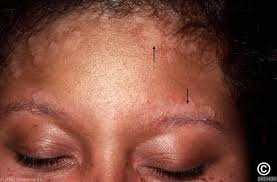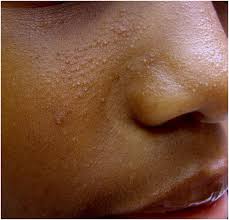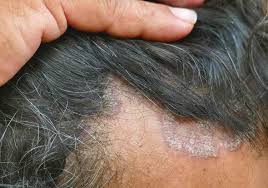Seborrheic Dermatitis in Dark Skin: Understanding, Managing, and Treating the Condition
Seborrheic Dermatitis in Dark Skin: Understanding, Managing, and Treating the Condition
Seborrheic dermatitis is a common skin condition that can affect anyone, but it sometimes presents unique challenges for people with dark skin. Characterised by flaky, itchy, and red patches, can be particularly bothersome on the face and scalp. In people with darker skin tones, this condition may appear differently, often showing up as lighter or darker patches that stand out from the surrounding skin. Let’s dive into how seborrheic dermatitis affects dark skin, ways to manage it, and treatments that can help.

What is Seborrheic Dermatitis?
Seborrheic dermatitis is a type of eczema that primarily affects areas with oil-producing (sebaceous) glands. People commonly find it on the scalp, but it can also appear on the face, chest, and other oily parts of the body. For people with dark skin, seborrheic dermatitis can sometimes lead to changes in skin pigmentation, making the affected areas appear lighter or darker than the surrounding skin.
Key Features of Seborrheic Dermatitis:
- Flaky or scaly patches
- Redness or discolouration
- Itchiness
- Particularly on the scalp and T-zone, there is oiliness.
How Does Seborrheic Dermatitis Appear on Dark Skin?
Seborrheic dermatitis often appears differently on dark skin compared to lighter skin tones. Here’s what to look out for:
- Colour Changes: On dark skin, affected areas might appear darker (hyperpigmented) or lighter (hypopigmented) than the surrounding skin.
- Flaking: The flaky patches may show up as white or yellowish scales, especially on the scalp.
- Redness or Irritation: Redness can be harder to spot on dark skin, but you may notice areas that feel irritated or tender to the touch.
This difference in appearance is important, as it can sometimes lead to misdiagnosis. A dermatologist with experience treating diverse skin tones can provide the best care for seborrheic dermatitis on dark skin.
Causes of Seborrheic Dermatitis in Dark Skin
Although the exact causes of seborrheic dermatitis are unknown, the following common factors may contribute to its development:
- Overgrowth of Yeast (Malassezia): This yeast lives on everyone’s skin, but in some cases, it overgrows, leading to irritation and inflammation.
- Genetic Factors: Some people are more prone to developing seborrheic dermatitis due to their genetics.
- Environmental Triggers: Cold weather, dry climates, and stress can all worsen seborrheic dermatitis.
- Hormonal Changes: Hormonal shifts, especially in puberty or stress, may trigger seborrheic dermatitis flare-ups.
Symptoms of Seborrheic Dermatitis in Dark Skin
People with seborrheic dermatitis often experience symptoms that can vary in severity. Here’s what to watch out for:
- Itching and Discomfort: Many people experience itching, especially on the scalp.
- Flaky Patches: Look for scaly or flaky areas on the scalp, around the nose, and even in the eyebrows.
- Changes in Skin Tone: Darker or lighter patches may develop, especially if the skin becomes inflamed.
- Oily or Greasy Skin: The affected areas may feel oilier than the rest of your skin.

Effective Treatment Options for Seborrheic Dermatitis in Dark Skin
Treating seborrheic dermatitis in dark skin often requires a gentle, consistent approach. Here are some effective treatment options:
1. Use suitable Shampoos
If seborrheic dermatitis affects your scalp, medicated shampoos can help. Look for ingredients like:
- Zinc Pyrithione: Reduces yeast and relieves itchiness.
- Ketoconazole: An antifungal that helps control yeast growth.
- Selenium Sulphide: Slows down cell turnover, reducing scaling.
Use a suitable shampoo 2-3 times a week for best results. Follow up with a gentle conditioner to prevent dryness.
2. Topical Treatments
Topical creams and ointments can be effective on the face and body. Consider using:
- Hydrocortisone Cream: Reduces inflammation and irritation. Use it sparingly as prescribed by a dermatologist, as this is a steroid cream and long-term use will thin the skin.
- Antifungal Creams: These target the yeast causing the irritation.
3. Moisturisers and Emollients
Moisturisers are essential, especially for dark skin, as dryness can worsen symptoms. Look for products that are:
- Fragrance-Free: Fragrances can irritate sensitive skin.
- Non-Comedogenic: These won’t clog pores, which is especially important if you have oily skin.
Bragan Skincare’s Atopic Cream is the perfect moisturiser.
4. Natural Remedies
Some people find relief from seborrheic dermatitis through natural remedies. While these don’t work for everyone, they can be worth a try:
- Apple Cider Vinegar: Dilute it with water and apply it to the scalp. Its antifungal properties may help reduce flakiness.
- Tea Tree Oil: Known for its antifungal and antibacterial properties, it can be diluted and added to shampoos.
Managing Seborrheic Dermatitis Long-Term
Since seborrheic dermatitis is a chronic condition, managing it over time is essential. Here are some tips:
- Consistency is Key: Stick with your treatment routine, even if your symptoms improve.
- Moisturise Daily: Keeping your skin hydrated can prevent dryness and scaling.
- Avoid Triggers: Cold weather, stress, and certain skincare products can trigger flare-ups.
- Avoid fragranced products: These will flair the condition.

Tips for Preventing Discolouration on Dark Skin
One unique challenge of seborrheic dermatitis on dark skin is the risk of hyperpigmentation (dark spots) or hypopigmentation (light spots) after a flare-up. Here’s how to manage this:
- Use Sunscreen: Protecting your skin from the sun can prevent discolouration from becoming more pronounced.
- Avoid Scratching: Scratching can irritate the skin and worsen pigmentation changes.
- Opt for Gentle Products: Harsh products can irritate the skin and increase the risk of discolouration.
FAQ: Seborrheic Dermatitis in Dark Skin
Q1: Can seborrheic dermatitis go away on its own?
A: Seborrheic dermatitis is a chronic condition, so it may come and go, but it typically doesn’t go away entirely without treatment.
Q2: Does seborrheic dermatitis cause hair loss?
A: In severe cases, seborrheic dermatitis on the scalp can cause temporary hair loss due to inflammation, but hair usually grows back with treatment.
Q3: Is seborrheic dermatitis contagious?
A: No, seborrheic dermatitis is not contagious. It’s caused by an overgrowth of natural yeast, not by a virus or bacteria.
Q4: How can I tell the difference between seborrheic dermatitis and dandruff?
A: Dandruff is often less severe and doesn’t usually include redness or inflammation. Seborrheic dermatitis may cause red, itchy patches along with flaking.
Q5: What’s the best way to treat seborrheic dermatitis on the face?
A: Use a gentle cleanser, avoid harsh exfoliants, and try an antifungal or hydrocortisone cream like Bragan Skincares Atopic Cream.
Q6: Can diet affect seborrheic dermatitis?
A: While diet isn’t a direct cause, reducing sugar and processed foods may help some people manage symptoms better.
Conclusion: Embracing Healthy Skin with the Right Care
Seborrheic dermatitis in dark skin can be challenging, but with the right approach, it’s manageable. By understanding how it appears on dark skin, choosing effective treatments, and following a consistent skincare routine, you can keep flare-ups under control. Remember, healthy skin takes time and care. With patience and the right products, you can soothe your skin and minimise discomfort.
If you’re unsure where to start, consult a dermatologist who understands the unique needs of dark skin. Together, you can create a treatment plan that keeps your skin healthy, clear, and comfortable.
Additional Tips for Managing Seborrheic Dermatitis in Dark Skin
Seborrheic dermatitis is a long-term condition, but managing it doesn’t have to be overwhelming. Here are some additional strategies to keep flare-ups to a minimum and maintain healthy, comfortable skin.
1. Create a Simple, Consistent Routine
Consistency is key when managing seborrheic dermatitis, especially for dark skin. Find a skincare routine that works and stick with it, even when symptoms improve. Overcomplicating your routine can irritate the skin, so keep it simple:
- Use a gentle cleanser daily.
- Apply medication or antifungal products as prescribed.
- Follow up with a lightweight moisturiser to keep skin hydrated.
2. Choose the Right Products for Your Skin Type
For those with dark skin, choosing products that cater to your skin type can make a difference. If you have oily skin, opt for non-comedogenic (won’t clog pores) products to avoid excessive oiliness. For dry skin, look for richer moisturisers or those with ingredients like ceramides and hyaluronic acid to maintain hydration. Try Bragan Skincare’s Atopic Cream.
3. Pay Attention to Seasonal Changes
Cold, dry weather can worsen seborrheic dermatitis symptoms, especially on the scalp. In colder months, consider using a humidifier to keep indoor air moist and protect your skin from becoming too dry. During warmer months, continue to follow your routine but avoid heavy products that can clog pores and irritate the skin.
4. Limit Styling Products on the Scalp
Hair products can contribute to seborrheic dermatitis flare-ups. Avoid heavy styling products like pomades, gels, or oils directly on the scalp, as they can block hair follicles and increase irritation. If you need to style your hair, try keeping products on the hair shaft rather than the scalp itself.
5. Be Patient with Skin Tone Restoration
When treating seborrheic dermatitis on dark skin, it’s common to experience temporary changes in skin tone, including dark or light spots. These pigmentation changes can take time to fade, sometimes even months after inflammation has subsided. To support even skin tone:
- Use Sunscreen: Daily sunscreen use helps prevent pigmentation changes from becoming more pronounced. Choose a broad-spectrum sunscreen with SPF 30 or higher.
- Incorporate Niacinamide: This ingredient can help improve skin tone and reduce the appearance of dark spots over time.
- Avoid Harsh Exfoliants: Over-exfoliating can worsen pigmentation issues. Stick to gentle products that don’t irritate the skin.
Myths and Facts About Seborrheic Dermatitis
There’s a lot of misinformation about seborrheic dermatitis, especially when it comes to how it affects different skin types. Here are some common myths and the facts behind them:
Myth: Seborrheic dermatitis only affects people with oily skin.
Fact: While it’s more common on oily areas of the skin, seborrheic dermatitis can affect anyone, regardless of skin type.
Myth: Seborrheic dermatitis on dark skin always causes permanent discolouration.
Fact: Skin discolouration from seborrheic dermatitis is usually temporary. With proper care and sun protection, the skin often returns to its natural tone over time.
Myth: You should wash your hair less if you have seborrheic dermatitis.
Fact: Regular cleansing with a gentle or medicated shampoo can help keep symptoms under control, especially on the scalp. Experts often recommend washing 2–3 times per week with a suitable shampoo.
Final Thoughts: Taking Control of Seborrheic Dermatitis on Dark Skin
Seborrheic dermatitis may be a long-term condition, but it doesn’t have to define your skin journey. For people with dark skin, understanding the unique ways this condition may appear and knowing which treatments are effective can make a significant difference. Remember, every skin type and tone is beautiful, and seborrheic dermatitis is just one part of your skin’s story.
With consistent care, patience, and a proactive approach, you can manage seborrheic dermatitis and keep your skin looking and feeling its best. Start with gentle products, avoid potential irritants, and follow a regular skincare routine tailored to your needs. If you ever feel uncertain, don’t hesitate to reach out to a dermatologist who specialises in diverse skin tones—they can guide you through a treatment plan that respects and celebrates your skin.
Ultimately, controlling seborrheic dermatitis on dark skin is all about empowerment, education, and embracing what works best for you. With the right care, your skin can stay healthy, comfortable, and radiant, helping you feel confident every day.
Featured Bragan Skincare Products
-
€39.99 – €100.00Price range: €39.99 through €100.00Select options This product has multiple variants. The options may be chosen on the product page
-
€100.00Select options This product has multiple variants. The options may be chosen on the product page

